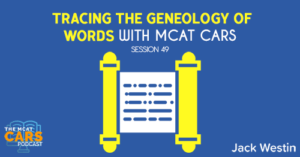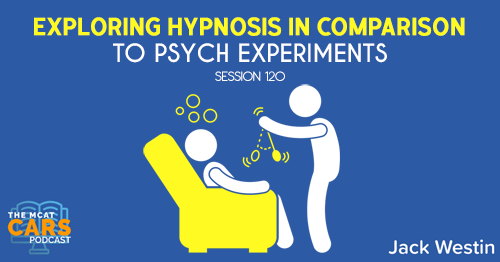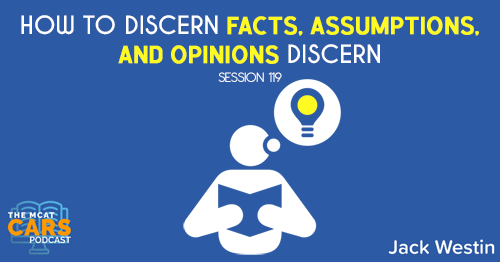Apple Podcasts | Google Podcasts

Session 49
This week is another straightforward passage all about language. We’re joined by Jack Westin as always as we dig deep into another passage so you can get the score that you deserve. And if you haven’t yet, be sure to check out all our other podcasts on Meded Media.
Listen to this podcast episode with the player above, or keep reading for the highlights and takeaway points.
[01:18] Jack Westin’s New Chrome Extension for AAMC MCAT Interface
Many students have trouble accessing AAMC practice passages. Unfortunately, the interface is not exactly like the MCAT. And you always want that practice environment, looking like the actual test as much as possible. So you would be more comfortable and you’re more aware of how the test works.
Good news! Jack Westin has created a Chrome extension where you click a button and it changes the design of your practice test to the actual MCAT design and all of its features. They just launched it and they’re hoping to perfect it soon. It’s really easy to use. So this is something to check out within the next couple of months.
Jack recommends resetting all your questions before using it to avoid any issues. It’s very useful feature. It’s not perfect but they’re working on it to make it better. If you have any suggestions, please email them at support@jackwestin.com.
Link to article:
http://nautil.us/blog/the-english-word-that-hasnt-changed-in-sound-or-meaning-in-8000-years
One of my favorite words is lox,” says Gregory Guy, a professor of linguistics at New York University. There is hardly a more quintessential New York food than a lox bagel—a century-old popular appetizing store, Russ & Daughters, calls it “The Classic.” But Guy, who has lived in the city for the past 17 years, is passionate about lox for a different reason. “The pronunciation in the Proto-Indo-European was probably ‘lox,’ and that’s exactly how it is pronounced in modern English,” he says. “Then, it meant salmon, and now it specifically means ‘smoked salmon.’ It’s really cool that that word hasn’t changed its pronunciation at all in 8,000 years and still refers to a particular fish.”
How scholars have traced the word’s pronunciation over thousands of years is also really cool. The story goes back to Thomas Young, also known as “The Last Person Who Knew Everything.” The 18th-century British polymath came up with the wave theory of light, first described astigmatism, and played a key role in deciphering the Rosetta Stone. Like some people before him, Young noticed eerie similarities between Indic and European languages. He went further, analyzing 400 languages spread across continents and millennia and proved that the overlap between some of them was too extensive to be an accident. A single coincidence meant nothing, but each additional one increased the chance of an underlying connection. In 1813, Young declared that all those languages belong to one family. He named it “Indo-European.”
Today, roughly half the world’s population speaks an Indo-European language. That family includes 440 languages spoken across the globe, including English. The word yoga, for example, which comes from Sanskrit, the language of ancient India, is a distant relative of the English word yoke. The nature of this relationship puzzled historical linguists for two centuries.
In modern English, well over half of all words are borrowed from other languages. To trace how language changes over time, linguists developed an ingenious toolkit. “Some parts of vocabulary are more stable and don’t change as much. The linguistic term [for these words] is ‘a core vocabulary.’ These are numbers, colors, family relations like ‘mother,’ ‘father,’ ‘sister,’ ‘brother,’ and basic verbs like ‘walk’ and ‘see,’ says Guy. “If you look at words of that sort in different languages, it becomes fairly clear which ones are related and which ones are not. For example, take the English word for number two, which is dva in Russian and deux in French, or the word night, which is nacht in German and noch in Russian.”
Analyzing the patterns of change that words undergo, moving from one language to another, showed how to unwind these changes and identify the possible originals. “Reconstructed vocabulary of Indo-European is based on a comparison of descendant languages,” explains Guy. “You collect words that mean more or less the same thing in all the languages, and if they look like each other in terms of their pronunciation, then it’s a good candidate for a descendant from a common ancestor.” The English word honey is madhu in Sanskrit and myod in Russian. Sanskrit and Russian haven’t shared a common ancestor since Indo-European, so these words had to come from the same source. (There are also the words mead in English, met in German and mjød in Danish that refer to an alcoholic drink made from honey.)
[05:00] Paragraph 1, Sentence 1
One of my favorite words is lox,” says Gregory Guy, a professor of linguistics at New York University.
Jack says:
Right off the bat, we’re given a name whose favorite word is the “lox.” Let’s keep reading to see what the word is.
[05:40] Paragraph 1, Sentence 2
There is hardly a more quintessential New York food than a lox bagel—a century-old popular appetizing store, Russ & Daughters, calls it “The Classic.”
Jack says:
So now we know it’s food. A lot of students may be thrown off by what “quintessential” means but we don’t really need to know what that word means. As long as you know it’s New York food and you’re good. But “quintessential” here means like it’s the greatest embodiment of New York.
[06:30] Paragraph 1, Sentence 3
But Guy, who has lived in the city for the past 17 years, is passionate about lox for a different reason.
Jack says:
Apparently, Guy likes the word for another reason.
[06:51] Paragraph 1, Sentence 4
“The pronunciation in the Proto-Indo-European was probably ‘lox,’ and that’s exactly how it is pronounced in modern English,” he says.
Jack says:
Here’s a little history of the word.
[07:06] Paragraph 1, Sentence 5
“Then, it meant salmon, and now it specifically means ‘smoked salmon.’
Jack says:
So now we’re told that it’s smoked salmon.
[07:25] Paragraph 1, Sentence 6
It’s really cool that that word hasn’t changed its pronunciation at all in 8,000 years and still refers to a particular fish.”
Jack says:
So the first paragraph talks about a linguistics professor, who is obviously someone who likes language. We’re focusing on a specific word. He’s giving us the word and what it means and he likes how it hasn’t changed in a thousand years.
The big picture here is that they educate you on what lox is. But that really doesn’t matter as much. What they really care more about is that the word hasn’t changed.
How to know whether this is more important than the meaning of the word is actually based on how the author presents the information. It’s the way the conversation plays out.
This is something that a lot of ESL students have trouble with. You have to figure out what direction the author is headed in.
For now, it’s in the direction of how the meaning of the word hasn’t changed. But we don’t really know it’s just guesswork until it’s more obvious. The way the author presents this stuff is said in a way that someone else said this.
'You have to ask yourself what's the purpose of this paragraph. What's the purpose the author is saying this stuff?'Click To Tweet[10:00] Paragraph 2, Sentence 1
How scholars have traced the word’s pronunciation over thousands of years is also really cool.
Jack says:
This shows how the author really likes this stuff and is focusing on it.
[10:14] Paragraph 2, Sentence 2
The story goes back to Thomas Young, also known as “The Last Person Who Knew Everything.”
Jack says:
We’re given a new name here.
[10:34] Paragraph 2, Sentence 3
The 18th-century British polymath came up with the wave theory of light, first described astigmatism, and played a key role in deciphering the Rosetta Stone.
Jack says:
Now, we know who Thomas Young is and we’re given some of his accomplishments.
[11:05] Paragraph 2, Sentence 4
Like some people before him, Young noticed eerie similarities between Indic and European languages.
Jack says:
So Young is a linguist as well.
[11:15] Paragraph 2, Sentence 5
He went further, analyzing 400 languages spread across continents and millennia and proved that the overlap between some of them was too extensive to be an accident.
Jack says:
We’re given a history of language here that Thomas Young has provided us with.
[11:33] Paragraph 2, Sentence 6
A single coincidence meant nothing, but each additional one increased the chance of an underlying connection.
Jack says:
The author is telling us about coincidence and connection.
[11:59] Paragraph 2, Sentence 7
In 1813, Young declared that all those languages belong to one family.
Jack says:
Now we’re given a specific time here.
[12:16] Paragraph 2, Sentence 8
He named it “Indo-European.”
Jack says:
The majority of the paragraph is about Thomas Young and his story of comparing languages and the similarities between languages. So he coined this Indo-European kind of terminology, which essentially predates all of our languages. It goes back to this once ancestor.
[13:04] Paragraph 3, Sentence 1
Today, roughly half the world’s population speaks an Indo-European language.
Jack says:
We’re given the extent of this language.
[13:14] Paragraph 3, Sentence 2
That family includes 440 languages spoken across the globe, including English.
Jack says:
We’re still given the extent here
[13:22] Paragraph 3, Sentence 3
The word yoga, for example, which comes from Sanskrit, the language of ancient India, is a distant relative of the English word “yoke”.
Jack says:
We’re given an example here.
[13:43] Paragraph 3, Sentence 4
The nature of this relationship puzzled historical linguists for two centuries.
Jack says:
This paragraph is mostly an example of the Indo-European language here. Notice that we’re not talking about lox anymore. So lox seems to be the main idea, but apparently, it’s not.
The passage is going towards the history of words. That’s what happens on this kind of test. They will bring in something in the first of the first two paragraphs that don’t necessarily contain any element of the main idea.
'Usually, you will find the point the author is trying to get across halfway through or near the end of each article you read.'Click To TweetSo in the first couple of paragraphs, they will introduce something just to get you interested. Then they delve into it more and more. Just keep track of that structure.
Understanding how it went from the first paragraph to the second and the third is a skill. And this is something you have to develop. Once you’ve developed, you would understand much better and you’ll be able to answer questions much faster.
[16:49] Paragraph 4, Sentence 1
In modern English, well over half of all words are borrowed from other languages.
Jack says:
Now the author talks about English specifically and where it comes from.
[17:00] Paragraph 4, Sentence 2
To trace how language changes over time, linguists developed an ingenious toolkit.
Jack says:
The author is teaching us a lesson on how we trace language.
[17:15] Paragraph 4, Sentence 3
“Some parts of vocabulary are more stable and don’t change as much.
Jack says:
We’re given more lesson on language.
[17:24] Paragraph 4, Sentence 4
The linguistic term [for these words] is ‘a core vocabulary.’
Jack says:
This is the terminology they used for the quote before this – “Some parts of vocabulary are more stable and don’t change…” So the core doesn’t change. So this sentence is describing the sentence before this.
[18:11] Paragraph 4, Sentence 5
These are numbers, colors, family relations like ‘mother,’ ‘father,’ ‘sister,’ ‘brother,’ and basic verbs like ‘walk’ and ‘see,’ says Guy.
Jack says:
The author is showing us what core vocabulary looks like.
[18:25] Paragraph 4, Sentence 6
“If you look at words of that sort in different languages, it becomes fairly clear which ones are related and which ones are not.
Jack says:
We’re being told how these languages compare and how we find these core vocabulary. So if you compared English to French, maybe those complicate words are not similar so you can’t see any relation. But if you start using the core vocabulary, you’ll start seeing similarities. And this is true for a lot of the words that we understand from other languages.
[19:14] Paragraph 4, Sentence 7
For example, take the English word for number two, which is dva in Russian and deux in French, or the word night, which is nacht in German and noch in Russian.”
Jack says:
Many of the words in Spanish or French are very similar to English. At least, they come up with similar letters to begin or end with or they look similar. And this explains it that they came from one ancestor, this Indo-European language.
[20:07] Paragraph 5, Sentence 1
Analyzing the patterns of change that words undergo, moving from one language to another, showed how to unwind these changes and identify the possible originals.
Jack says:
Again, this talks more about language and how we figure out where they came from.
[20:25] Paragraph 5, Sentence 2
“Reconstructed vocabulary of Indo-European is based on a comparison of descendant languages,” explains Guy.
Jack says:
This is just basically repeating the same sentence.
[20:35] Paragraph 5, Sentence 3
“You collect words that mean more or less the same thing in all the languages, and if they look like each other in terms of their pronunciation, then it’s a good candidate for a descendant from a common ancestor.”
Jack says:
When you read something and you start understanding it, you start enjoying it more. When you’re good at something, you enjoy it more. So you can actually start enjoying reading and answering CARS questions if you are good at it, which is a skill. You can work on those little things that differentiate a high-scoring student from a lower-scoring student.
[22:55] Paragraph 5, Sentence 4
The English word honey is madhu in Sanskrit and myod in Russian.
Jack says:
Just more examples.
[23:05] Paragraph 5, Sentence 5
Sanskrit and Russian haven’t shared a common ancestor since Indo-European, so these words had to come from the same source.
Jack says:
They’re comparing both similar looking languages. And so this author is saying this probably came from the same place.
[23:33] Paragraph 5, Sentence 6
(There are also the words mead in English, met in German and mjød in Danish that refer to an alcoholic drink made from honey.)
Jack says:
This is one final example of this common ancestral language.
[24:00] The Big Picture
There could be so many possible questions on this stuff. Like imagine this word and it may ask which one would the author would say is most similar to it. And the author uses pronunciation as the basis of their similarity. So you have to pick something that sounds the same way. Pronunciation is one way that they use to make that similarity.
So the big picture here is that languages come from a core vocabulary and their pronunciations are similar. If you know those little details and the context within this bigger idea then you should be able to get every question right.
[25:27] Jack Westin
If you’re looking for some more great resources, go to Jack Westin. They offer a course for a more in-depth, one-on-one personal help. They also have the free daily MCAT CARS passages delivered right into your inbox.
Links:
Link to article:
http://nautil.us/blog/the-english-word-that-hasnt-changed-in-sound-or-meaning-in-8000-years
SEARCH SITE
SEARCH SITE
LISTEN FOR FREE











